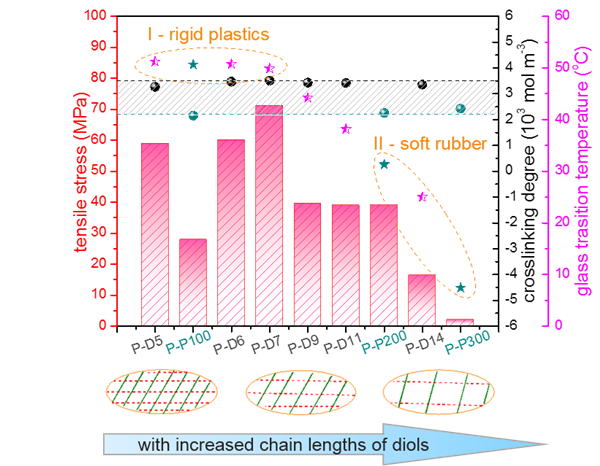Functional Biopolyesters Based on Cross-linked Poly(L-malic acid): Network Engineering towards Tailoring Brittle-Ductile Transition and Shape-Memory Performance
作者:Qianru Wanyan, Yaxin Qiu, Wenting Zhang, Hai Yu, Defeng Wu*
关键字:biodegradable polyesters; crosslinking networks; brittle-ductile transition; asynchronous actions; intelligent devices.
论文来源:期刊
具体来源:Polymer
发表时间:2021年
Polymer, 2021, 221, 123628.

Crosslinking opens more possibilities of biodegradable poly(L-malic acid) (PLMA) as functional materials, and network structure is key to its mechanical states and final applications. In this work, the diols with various chain lengths, including six types of fatty diols and four types of polyethylene glycols, were used to construct networks in PLMA, aiming at establishing network structure-mechanical state-material function correlations. As the molecular weights of diols increased from 100 to 400, the samples experienced evident transition from high-strength plastic to low-loss rubber, finally to soft elastomer. The strengths and Young''''''''''''''''s moduli varied from 71 MPa to 0.6 MPa and from 2.3 GPa to 2.7 MPa, respectively, accompanied by a broad variation of glass transition temperature (Tg, 50 oC-7 oC). This brittle-ductile transition was revealed in terms of elastoplastic and dielectric relaxations, then. Using the samples with different network structures as components, the actuators with attractive capability to complete asynchronous actions were fabricated. This work proposes promising applications of cross-linked PLMA as functional or smart materials due to its easily-tuned mechanical states and Tg, together with its good antibactierial activity and shape memory effect.
PDF DOWNLOAD:
https://linkinghub.elsevier.com/retrieve/pii/S0032386121002512